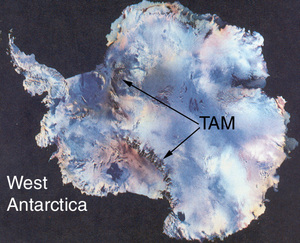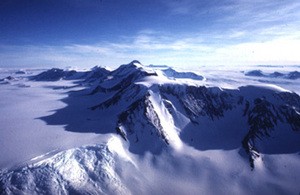The DNA of ancient microorganisms, long frozen in glaciers, may return to life as the glaciers melt, according to a paper published in the Aug. 14 edition of the Proceedings of the National Academy of Sciences.
The finding is significant, said Kay Bidle, assistant professor of marine and coastal sciences at Rutgers, because scientists didn't know until now whether such ancient, frozen organisms and their DNA could be revived at all or for how long cells are viable after they've been frozen. Bidle is lead author of the article, "Fossil Genes and Microbes in the Oldest Ice on Earth."

|
| ©University of Arizona |
| Ice samples for the study were collected in the Transantarctic Mountains in western Antarctica. |
The researchers wanted to find out how long cells could remain viable and how intact their DNA was in the youngest and oldest ice.
"First, we asked, do we detect microorganisms at all?" Bidle said. "And we did - more in the young ice than in the old. We tried to grow them in media, and the young stuff grew really fast. We recovered them [the microorganisms] easily; we could plate them and isolate colonies. They doubled every couple of days." By contrast, Bidle said, the microorganisms from the oldest ice samples grew very slowly, doubling only every 70 days.
Not only were the microorganisms in oldest ice slow to grow, the researchers were unable to identify them as they grew, because their DNA had deteriorated. In fact, the DNA in the five samples examined showed an "exponential decline" after 1.1 million years, "thereby constraining the geological preservation of microbes in icy environments and the possible exchange of genetic material to the oceans."
"There is still DNA left after 1.1 million years," Bidle said. "But 1.1 million years is the 'half-life' - that is, every 1.1 million years, the DNA gets chopped in half."

|
| ©NSF |
| The Transantarctic Mountains are one of the longest mountain chains in the world, and divide the ice sheet of Antarctica into two parts. |
Bidle said the average size of DNA in the old ice was 210 base pairs - that is, 210 units strung together. The average genome size of a bacterium, by comparison, is 3 million base pairs.
The researchers chose Antarctic glaciers for their research because the polar regions are subject to more cosmic radiation than the rest of the planet and contain the oldest ice on the planet.
"It's the cosmic radiation that's blasting the DNA into pieces over geologic time, and most of the organisms can't repair that damage."
Because the DNA had deteriorated so much in the old ice, the researchers also concluded that life on Earth, however it arose, did not ride in on a comet or other debris from outside the solar system. "...(T)he preservation of microbes and their genes in icy comets may have allowed transfer of genetic material among planets," they wrote. "However, given the extremely high cosmic radiation flux in space, our results suggest it is highly unlikely that life on Earth could have been seeded by genetic material external to this solar system."
The five ice samples used in the experiment were taken from two valleys in the Transantarctic Mountains by Marchant, the Boston University glaciologist. "He sent us blocks of ice," said Bidle of Marchant. "Without them, we couldn't have done the work. Dave is also one of the few researchers who is knowledgeable about the age of the ice, and also important information about the formation and geology of the ice."
The actual melting of the ice, growing of microorganisms and examination of DNA was carried out by Bidle and Lee, who was a visiting researcher at Rutgers at the time. Falkowski co-directed the research and helped to write the paper. The work was funded by a grant to Falkowski and Bidle from the Gordon and Betty Moore Foundation.



Reader Comments
to our Newsletter